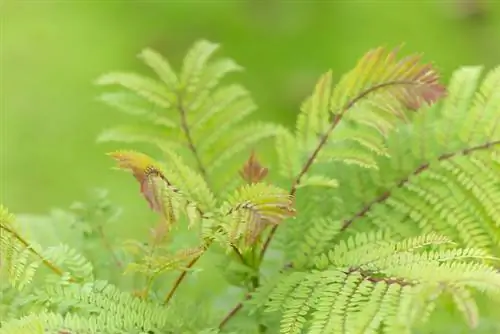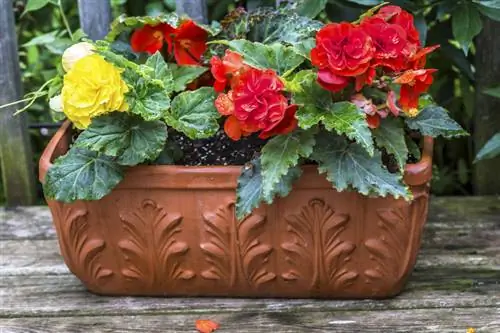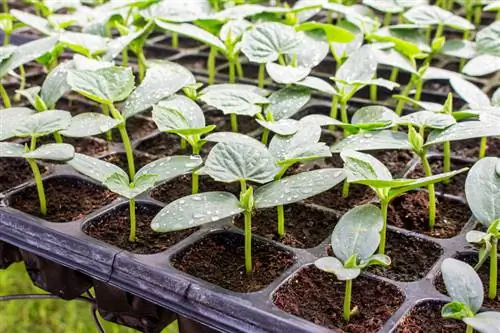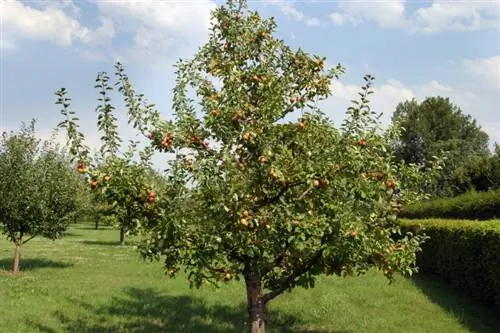- Author admin [email protected].
- Public 2023-12-16 16:46.
- Last modified 2025-01-23 11:21.
The jacaranda tree is also very popular as a bonsai because of its good pruning tolerance, although it does not develop its impressive flowers when grown indoors. What you need to consider when cutting, wiring and caring for a jacaranda as a bonsai.

How do I care for a jacaranda bonsai?
To care for a jacaranda bonsai, it needs a bright, wind-protected location, regular watering, fertilization from spring to autumn, pruning every six to eight weeks and frost-free wintering at temperatures above 10 degrees Celsius.
The Jacaranda tree comes from the tropics of South America
The jacaranda comes from the subtropics and is therefore used to warm climates. It does not tolerate any frost and needs relatively high temperatures even in winter.
The decorative flowers do not appear indoors or when kept as a bonsai. Only when the tree has reached a certain height can it develop inflorescences.
Therefore, the Jacaranda is grown as a bonsai primarily because of its feathery leaves.
A good location for the jacaranda bonsai
The location of the jacaranda must be as bright as possible. However, he doesn't like direct sunlight that much. If it stands outside in summer, it needs a place protected from the wind.
The temperatures at the location of the rosewood tree should be between 20 and 25 degrees in summer. In winter they must not fall below 14 degrees.
Cutting jacaranda as a bonsai
The jacaranda tolerates cutting very well. The styles forest and solitary are suitable as bonsai shapes.
The jacaranda is cut every six to eight weeks. Pruning begins in May. From October you are no longer allowed to cut the tree.
In addition to the branches and twigs, the roots are also trimmed when repotting. This is the only way to achieve a pleasant appearance of the Jacaranda tree.
How to wire the rosewood tree correctly
The branches of the jacaranda can be easily shaped by wiring. The shoots and the trunk are wrapped spirally with wire, always from bottom to top. The wire should be neither too loose nor too tight.
Since the branches, twigs and trunk begin to grow thicker in May, you should remove the wire now to prevent unsightly wire marks.
Proper care of jacaranda as a bonsai
- Water regularly
- fertilize
- repotting
- cutting
- overwintering
Water and fertilize jacaranda as a bonsai
In order to care for the jacaranda as a bonsai, you must attach particular importance to the correct watering and fertilization.
The root ball should never dry out completely. But waterlogging is just as damaging. Always only water when the top layer of the substrate has dried. Do not leave water standing in the saucer or planter. When watering, use stale, warm tap water or, better yet, rainwater that is not too cool.
The jacaranda is fertilized from spring to autumn. Suitable fertilizers are liquid fertilizers or fertilizer cones (€4.00 on Amazon) for organic-based bonsai. Apply the fertilizer according to the instructions on the package. In winter and after repotting, do not fertilize the jacaranda anymore.
How to repot
When caring for it as a bonsai, you should repot the jacaranda at least every two years. This is important not only because of the size of the pot, because a new bowl is only necessary when the root ball pushes out from the top. Replacing the planting substrate also ensures that the plant remains he althy. The best time to repot is spring, when you take the jacaranda out of winter quarters.
Take the jacaranda out of the old pot and shake off the old substrate. Prune the roots so that they branch better and the tree stays small.
Bonsai soil from the garden supply store is suitable as a planting substrate. You can also mix the substrate yourself, one third at a time:
- Akadama
- Humus
- Lavas chippings
Identify pests and treat them immediately
The Jacaranda is quite robust if you care for it properly. Infestations by whiteflies or spider mites can occasionally occur.
You can recognize whiteflies by the winged pests that can be found on the underside of the leaves. Spider mites are barely visible to the naked eye. Mist the jacaranda leaves with water. If small webs appear in the leaf axils, this is a sign of spider mites.
You should treat a pest infestation immediately to prevent it from spreading. Rinse the jacaranda in the shower to remove the pests. Cover the soil while doing this. Use commercially available pesticides that you stick into the soil.
Overwinter Jacaranda frost-free
The Jacaranda is not hardy. It needs to be kept frost-free and quite warm over the winter. The ideal temperatures in winter are between 17 and 19 degrees. It shouldn't get colder than ten degrees.
The winter location should be as bright as possible. Watering is very sparse in winter, so you avoid fertilizing at all during this time.
Tip
In winter the jacaranda usually doesn't get enough light. It then sheds its leaves. But that's not a problem because the leaves will sprout again when it gets more light again in spring.






